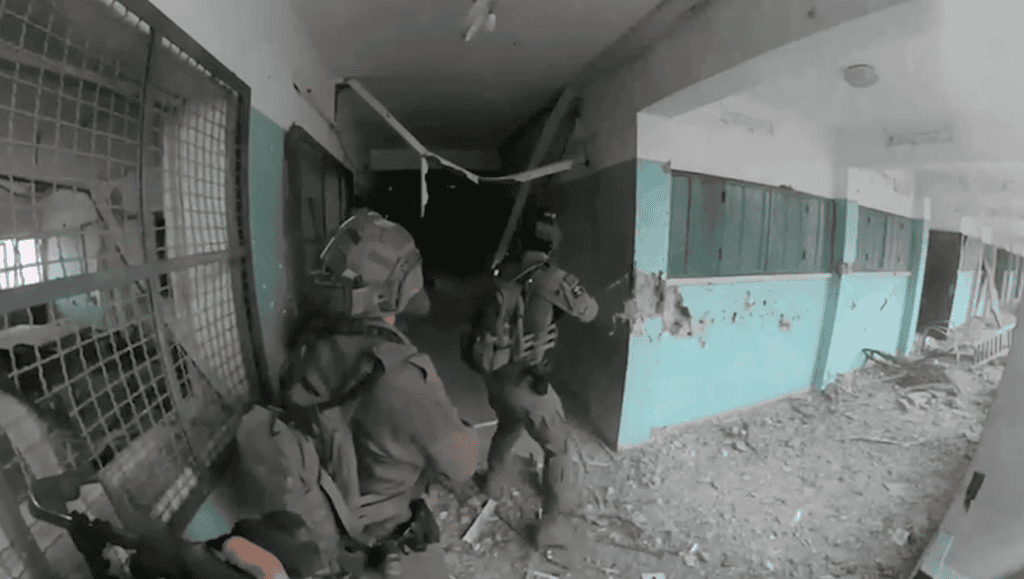
In one week of the fighting that resumed following a pause, Israel faced challenges on its northern border with Lebanon as well as in Gaza where 25 IDF soldiers were killed. This brings the total number of IDF soldiers killed since October 7 to 420.
While fighting continued in northern Gaza, this week saw a rapid advance into the dense urban areas of Khan Yunis, where Hamas commanders are believed to be. This surprise maneuver occurred with Israel’s 98th division, which includes commando forces. Entering Khan Yunis also meant IDF forces around Gaza City in the north are still clearing neighborhoods. The two neighborhoods that have been focal points of fighting this week are Shujaiya and Jabalya. Each has a Hamas battalion for fighters that must be defeated and was densely populated before the war. Although most have moved south to a humanitarian area near the sea, some civilians remain.
In Shujaiya, the IDF said its elite counter-terrorism unit, Lotar, is operating for the first time. This unit saw action on the first day of the war on October 7 when it arrived as a quick response force in Sderot and in other areas attacked by Hamas. The IDF said the unit was operating alongside an armored brigade during battles in the area. “The squad includes soldiers specialized in breaching and demolitions, as well as snipers, who have been operating with elite units since the start of the ground operation,” the IDF said.
The IDF said on Friday morning that between December 7 and 8, more than 450 targets were struck by air, ground, and naval forces. “As part of IDF activity in Khan Yunis, IDF troops directed IAF aircraft to kill numerous terrorists in a two-hour series of precise strikes. Three terrorists identified by the troops were struck by a UAV. Two of them were killed and the third one revealed the location of the other terrorists who were hiding in a military compound preparing to launch rocket fire at our forces,” the IDF said. The Israeli navy also struck terror infrastructure along the coast of central and southern Gaza. “The terror targets that were struck included military sites and posts where Hamas terrorists were operating, observation posts, and storage compounds containing weapons.” The IDF has used its relatively small navy heavily since October 7. Israel’s navy was bolstered several years ago with four new corvettes. These are packed with Israel’s latest defense technology from their three defense giants; Elbit Systems, Rafael Advanced Defense Systems, and Israel Aerospace Industries. As such, they have bolstered the IDF’s ability to operate from the sea and knit together ground and air forces and naval sensors.
The IDF provided some spotlight on its operations around Gaza overnight and on December 8. In the north on Thursday, soldiers found a tunnel under the ruins of Al-Azhar University in Rimal, a scene of fighting last month. The IDF also found a former Hamas observation and control room near Shati hospital north of Rimal near the coast. This is another area secured in fighting last month.
In southern Gaza, the IDF noted that its 7th armored brigade had been used to break through Hamas lines in battles in Deir al-Balah, north of Khan Yunis. In Khan Yunis itself, the IDF said that the “Givati Brigade, the 55th Brigade, and the 4th Brigade are encircling the city and conducting operations and raids on the battalions of the Khan Yunis Brigade of the Hamas terrorist organization.” The IDF also said the new Iron Sting 120mm precision mortar was used. This is one of several new types of IDF systems being used in Gaza, along with the new wheeled Eitan APC and Firefly loitering munition.
The IDF also appeared to have suffered a setback during a raid attempting to free hostages in which two of its soldiers were injured. “During the operation, numerous terrorists who took part in the abducting and holding of hostages were killed,” the IDF said. However, no hostages were rescued. Hamas holds 138 hostages in Gaza. Hamas claimed it had foiled the hostage rescue, and the terrorist group claims hostages had been killed in this incident as well as in a subsequent bombing later that evening. Hamas has made these kinds of claims in the past. “Hamas tries to weaponize psychological terror. Please refrain from spreading unverified rumors and enabling psychological terror by Hamas,” the IDF said.
At the Lebanese border, Hezbollah increased attacks late on December 7 and throughout December 8. In addition, there was a threat from Syria and two rockets were launched in response. Hezbollah targeted the border communities of Malkia, Zarit, Shtula, Mount Dov and Mattat. Two soldiers were wounded in the attack on Shtula. The IDF said it used a drone to strike terrorists threatening Mount Dov. The mountain is part of a disputed area at the Lebanon-Israel-Syria border. In addition to striking targets in Syria, the IDF shot down a drone from Lebanon. The IDF also said that Israeli forces struck Hezbollah targets throughout the day.
Israel generally continues to conduct proportionate responses at its borders with Lebanon and Syria, and the attacks appeared to increase on Thursday and Friday. In addition, there was a shooting attack in the West Bank. Hamas targeted Ashkelon and Tel Aviv with barrages of rocket fire, despite the fact that the general the ability of Hamas and Palestinian Islamic Jihad to fire rockets from Gaza has been greatly reduced in the last week of fighting. The IDF has said that Hamas now seeks to fire rockets from near the humanitarian zone in Gaza.







